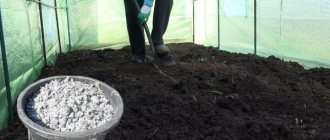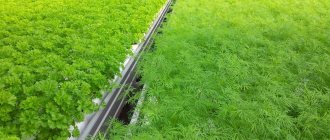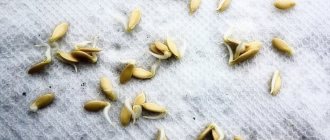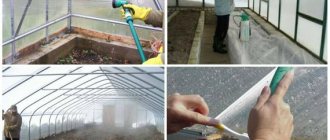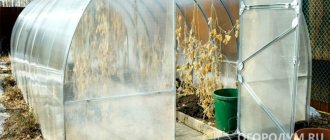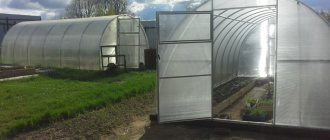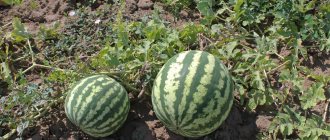Carrying out pre-landing activities
To implement plans to obtain a watermelon harvest in a greenhouse, it is worth preparing responsibly. The possibility of the growing process itself depends on the choice of greenhouse, its equipment and the preparedness of the soil in it.
Choosing a greenhouse
The size of the shelter space and design option depend on the gardener. It is better to give preference to polycarbonate structures, as they are easy to assemble and operate and can withstand weather disasters. Their high cost pays off quickly.
Film greenhouses, although they are an order of magnitude cheaper, are suitable for testing the method of obtaining a watermelon harvest, but on a serious scale they will require the investment of additional expenses and effort.
Since watermelon is a crop that requires an increased amount of space, the size of the greenhouse for growing 10 plant roots must be at least 10 square meters. m. Consider a height of 2 m to ensure convenience for carrying out agricultural technology and not limit the growth of the watermelon. Place trellises and garter material indoors.
When the greenhouse is installed, check it for any cracks in the frame or in the joints of the polycarbonate sheets. If any are found, eliminate them. This will save the seedlings from drafts and inevitable death.
To avoid the occurrence of fungal diseases, treat the interior with a solution of copper sulfate, diluting it in water in a ratio of 1:100, or with Bordeaux mixture.
Install additional sources of heat and light. You can lay heating pipes under the beds so that the soil also has the opportunity to warm up.
Soil preparation
Soil quality is of great importance for growing watermelons. There are several options for preparing the soil:
- Remove 20 cm thick soil from the greenhouse. In its place, lay a layer of straw and humus, and sprinkle nitrate fertilizers on top. Water well so that the straw is saturated with water and the fertilizer is dissolved. Fill the removed soil on top and cover it with a dark film. It is recommended to carry out planting work on this soil after 7-10 days.
- Dig up the soil, adding organic matter to it. Humus is suitable if you plan to plant watermelons in the near future, or manure if you will be planting seedlings in 2-3 months.
- Form artificial beds with a height of at least 30 cm. To do this, make fences from boards and pour inside a mixture of garden soil and river sand (10 kg per 1 sq. m), adding nitrogen and phosphorus mineral fertilizers (10 g per 1 sq. m) . m).
Please note that watermelons prefer soils with a pH level between 6-7. If the soil is highly acidic, it is recommended to add limestone, chalk, and wood ash at the rate of 300-700 g per 1 sq. m. m of land. For alkaline soils, they need to be acidified with humus - 5-7 kg per square meter. m or manure - 2-3 kg per sq. m.
Organic matter also increases the soil’s ability to allow air and water to pass through, making the soil looser and lighter. Sand is added for the same purposes.
The neighborhood of watermelons with other crops
You can plant other plants with watermelons. This is, first of all, a melon, which also belongs to the pumpkin family. Melons grow well next to tomatoes, eggplants, bell peppers and other drought-resistant plants .
Important! It is better not to grow moisture-loving crops nearby. Melons do not like high air humidity and drafts. They begin to rot at humidity levels above 60%.
Cucumbers, for example, love water very much and need regular ventilation. This does not mean that they cannot be planted in the same greenhouse with watermelons. It is possible, but only on condition that the watermelons are allocated a windless, dry corner, and the cucumbers at the other end are provided with the necessary watering and ventilation. Before planting watermelon seedlings in the beds, you can have time to get a harvest of greens and radishes. They will not harm watermelons.
Advantages and disadvantages of growing watermelons in a greenhouse
The technology for growing watermelons in a greenhouse has its positive and negative components.
The advantages of this method include:
- No influence of external climate on plants. Regardless of the temperature outside the shelter, the microclimate in the greenhouse has its own stable indicators. You should not be afraid of any manifestations of the weather and worry about their negative impact on the melon crop.
- Mechanical damage to the plant and fruit is practically reduced to zero. In a closed greenhouse, the wind does not overturn the watermelon vines, and animals and other pests do not have access to the plant.
- Quality of watermelon pulp. The constancy of the microclimate allows watermelons to ripen and gain sweetness, so their flesh is juicy and sweet.
The only drawback of growing watermelons in a greenhouse is the pointlessness of this process in the southern regions, where plants have enough heat and other weather and climatic conditions to ripen without shelter. The profitability of such a process may become negative.
Selection and preparation of planting material
When choosing a watermelon variety for greenhouse cultivation, you should give preference to those varieties that are characterized by small fruits. The region in which the seed was produced plays an important role in the choice of planting material. You have to buy seeds that adapt to your climatic conditions.
When choosing a variety for indoor growing, preference should be given to varieties with a short ripening period
Paying attention to the timing of watermelon ripening, it is worth noting that for indoor soil it is better to choose early ripening varieties that will ensure normal ripening of the crop. Perennial varieties will not leave you with anything. Such watermelons can safely be grown only in the southern regions. Of the early ripening varieties, we can recommend: Ogonyok, Sibiryak, Tsenerentola, Dar Severu F1, Krymstar F1, Siberian Lights, Pink Champagne F1.
In addition to choosing seeds, they also need to be properly prepared for planting. The first thing you need to do is throw away the seeds. To do this, they are poured into a container with water, and those seeds that have sprouted are considered unsuitable for planting. Then the planting material is treated in a weak solution of potassium permanganate for 10 minutes, which is necessary for disinfection.
Disinfection of planting material with potassium permanganate eliminates bacteria and fungal spores on the surface of the seeds
It should be borne in mind that watermelon seeds have poor germination. This indicates the need to take measures to accelerate germination. To improve germination, seeds are preheated to a temperature of + 55˚C for three hours or placed in a sunny place for a week. As a preparatory measure, watermelon seeds are also soaked in water at room temperature for a day. The fact that the seeds are ready for germination can be judged by their appearance: if swelling and an increase in size are noticeable, it’s time to start germination.
To improve germination, watermelon seeds are pre-soaked in a nutrient solution or water.
You can germinate seeds either simply in a damp cloth bag or with pre-treatment with growth stimulants and fertilizers (Zircon, Epin, humic preparations). The grains are then washed with water, wrapped in dampened gauze and placed in a warm place, checking periodically and, if necessary, wetting the cloth, and also checking for seed hatching. In addition to all the steps, the seeds can be covered with film, which will create favorable conditions for germination.
To make the seeds germinate faster, they are wrapped in damp gauze and placed in a warm place.
Choosing a watermelon variety for growing in a greenhouse
For growing in shelters, it is advisable to choose varieties and hybrids with a short ripening period. We invite you to get acquainted with some of the most popular watermelon varieties suitable for cultivation in mid-latitudes:
- Siberian . A variety specially bred for cultivation in the regions of Siberia. The fruits are sweet, medium in size, their weight is up to 5 kg. The crust is not thick, the flesh is rich scarlet in color, and contains a lot of sugar. The variety is not afraid of fluctuations in air temperatures and produces high-quality ovaries even at low temperatures.
- Crimson . An early ripening variety, ripening is observed at 70-75 days. The peel is matte with green stripes of dark and light green. The pulp is juicy and red. The weight of the fetus can range from 5 to 12 kg. Moderately resistant to anthracnose.
- Ogonyok . Early ripening variety. The growing season ranges from 70 to 80 days. The weight of the small spherical fruit reaches 2.5 kg. The juicy sweet core of a fiery color is covered with a thin dark peel of a dark green hue with virtually no pattern. The seeds are not large. The variety is unpretentious in cultivation, but does not last long. Characterized by an average degree of resistance to powdery mildew and anthracnose.
- Sugar . Ultra early variety. The fruits appear on the 65-75th day. The peel is thin, green with a barely noticeable pattern. The pulp is rich red, representing a mass of large grains, sweet, juicy. The weight of the fruit is about 3 kg, rarely growing up to 5 kg. The variety is unpretentious, cold-resistant, and can be transported and stored.
- Florida . Mid-season hybrid with a growing season of up to 100 days. The fruits are elongated. The pulp is juicy and aromatic. The crust is hard, colored with blurry stripes. Suitable for transportation, can be stored for up to 3.5 months.
watermelon variety “Sibiryak”
watermelon variety “Crimson”
watermelon variety “Ogonyok”
watermelon variety “Sugar”
watermelon variety “Florida”
Sowing seeds and growing seedlings
Before you start growing watermelon seedlings, you should familiarize yourself with the features of planting seeds and their germination until the first shoots appear.
Preparing seeds
Only pre-prepared seeds that have been pre-treated should be planted in the ground. When preparing seeds before planting, be sure to warm them up. The procedure is carried out to remove all bacteria and pathogens from the surface of the seed. To warm up, you will have to use special heating devices.
For example, you can place the seeds in the oven for 5-7 minutes. The first few minutes it should be heated to 20-30 degrees, after which the heating temperature gradually increases to 60 degrees. During heating, all the seeds are periodically stirred so that they warm up more thoroughly.
Also, to disinfect seed material, use manganese liquid. To create a mixture, add 2-3 grams of manganese to 100 milliliters of water. Then the seeds are placed in a container and soaked in it for about half an hour. Some gardeners add wood ash to the solution during the procedure to speed up the process of seed germination. After removing the seeds from the manganese solution, they are washed with running water and dried.
Containers and soil
Experienced gardeners advise, to grow watermelon seedlings, to plant the seeds in bulk or peat-humus pots. You can also use cardboard egg trays or plastic cassettes for planting melons. However, some people use peat pots.
Having decided on the most suitable container for watermelons, they begin to prepare the soil mixture for planting. Planting seeds should be done in previously prepared soil filled with nutrients. When creating a soil mixture, humus is added to the ground, which is made from rotted plants or manure. Peat is also considered an essential component, which is often used to improve soil fertility. It makes the soil looser, allowing moisture to penetrate into its upper layers faster.
After preparing the soil, they plant the seeds. To do this, shallow depressions are made in the soil, into which 2-3 seeds are placed. When the seedlings grow to 5-8 centimeters, they are transplanted into a greenhouse.
Preparing seedlings
To obtain good harvests, you cannot do without proper preparation of seeds and growing healthy seedlings from them.
Sowing seeds
Before sowing seeds, it is recommended to prepare them. For this:
- Dissolve 1 tsp in 100 g of running water. table salt. Dip the seeds into the liquid. Remove all seeds remaining on the surface - this seed material will be of no use, they are empty. Rinse the remaining seeds with clean water.
- Prepare a slightly pink solution of manganese and soak the seeds in it for 20-30 minutes. This procedure will disinfect the seed material and protect against the development of fungal diseases.
- Place a cotton cloth in the saucer. Wet it well with warm water and spread the watermelon seeds over it in an even layer. Cover the top with the same moistened piece of cloth or plastic bag. Place in a warm place for swelling and germination. Make sure that the fabric is always damp and spray it with water.
Soaking the seeds in a growth stimulant before sowing will speed up the appearance of the first shoots.
When the seed material germinates, you can begin planting it in separate containers. For this, it is recommended to use peat glasses, but any other container of suitable size will do. Fill the glasses with prepared soil and place the seeds in it to a depth of 3-4 cm, placing them horizontally in the ground. Place the container in a warm place with an air temperature of at least 25 °C.
Growing seedlings
When the first leaves appear, create the necessary conditions for the seedlings to keep them healthy and strong:
- Use additional lighting with phyto- or fluorescent lamps so that the total daylight hours for the plant are at least 12-14 hours a day.
- Water the plant so that moisture does not fall on the leaves.
- As the seedlings grow, the distance between the pots should be increased so that the plants do not shade each other.
- Rotate the containers periodically so that the plants do not stretch to one side, but grow evenly.
- Feed the seedlings every 10-14 days. To do this, dilute 250 g of wood ash in 10 liters of water and use the solution for watering. Nitrogen fertilizers have a good effect. For example, 20 g of urea per bucket of water.
Planting watermelon seedlings in a greenhouse: step-by-step diagram
When 3-4 main leaves are formed on the plants, you can proceed to transplanting it into the greenhouse:
- Divide the area for planting into beds. For single-line planting, it is enough to make a ditch 10-12 cm deep and distribute the seedlings in it at a distance of 70 cm from each other.
- For a two-line planting, it is preferable to make holes 30x30 cm in size and 10 cm deep, placing them at a distance of 50 cm from each other.
- Water the ruts or holes well with water.
- Dip a peat pot with seedlings into it and sprinkle with earth, lightly tamping. It is allowed to place 2 seedlings into the hole along the edges, planting them at an angle in opposite directions from each other.
- If the seedlings were grown in reusable containers, then water them well the day before planting so that when the seedlings are removed, the earthen ball does not crumble and damage the root system of the seedling.
- After planting, the seedling substrate should protrude slightly above the soil surface. This will reduce the likelihood of the seedling stems turning black and rotting.
In the presented video you can see the process of planting watermelon seedlings in a greenhouse:
How to prepare a greenhouse?
Only in a greenhouse specially equipped for growing watermelons can you reap a rich harvest. Otherwise, watermelons, of course, will give birth, but in small quantities. The most optimal for growing watermelons is a polycarbonate greenhouse. What should a greenhouse be like?
Only in a greenhouse specially equipped for growing watermelons can you reap a rich harvest
- Equipped . In this case we mean a trellis. A simple garter and support will not do. Only a reliable trellis can support the weight of the plant and the berries on it.
- Warm . It is best to grow watermelons separately from other crops, although they get along with melons, cucumbers, peppers and eggplants. The fact is that watermelons need high air temperatures - at least +30 degrees and low humidity, and this can harm other crops. It is the polycarbonate greenhouse that retains heat best and is the most optimal for growing watermelons.
- High . In greenhouses, watermelons are grown vertically. But given that they curl strongly, the height of the greenhouse should be at least 2-2.5 meters. This is really very important, otherwise the plant simply won’t develop well and this will reduce the yield and make it more difficult for the gardener to care for.
After the snow melts, you need to start working in the greenhouse. To begin with, it is worth inspecting it for integrity - in case there are cracks or breaks somewhere, the trellis must also be reliable, as in the first year after installation. If there are any problems or malfunctions, everything must be repaired and repaired before seedlings appear in it. The soil should be fertilized; neutral, fertile soil is made for watermelons.
Agricultural technology of watermelons in a greenhouse
Agrotechnical measures for caring for watermelons are not difficult, but they should not be neglected.
Temperature and humidity conditions
The optimal temperature for the growth and development of watermelons is 24-26 degrees. It is very important to avoid sudden fluctuations. In cold climates, the use of heating in a greenhouse is mandatory.
The formation of condensation in a greenhouse and excessive air humidity lead to the spread of diseases. Ventilate the room daily. On hot days, you can leave the greenhouse open all day.
Watering
Properly organized watering is necessary for the growth and development of plants. With a lack of moisture, the leaves and vines of watermelons wither. It is enough to carry it out 1-2 times a week, but generously. Or water the beds with moderate amounts of water every other day. Do not overdo it with the amount of moisture when watering, otherwise the fruits will begin to crack. Keep in mind that watermelon is a drought-resistant crop.
When watermelons ripen, sharply reduce the amount of watering. This will allow the berries to grow fragrant and sweet.
Water at room temperature is considered optimal for moistening beds. When watering, make sure that it does not fall on the green parts of the plant, but is directed towards the root system. As the soil dries out after watering, make sure that a dry crust does not form on the surface of the soil. Loosen the soil in a timely manner.
Forming watermelons
An important step on the path to harvest is the formation of watermelon bushes. 10-15 days after planting the seedlings in the greenhouse, after adaptation to new conditions, it must be tied up, indicating the growth guide and preparing the bush for further activities.
Side vines empty of inflorescences are immediately removed. Pinch shoots with ovaries, leaving 3-4 leaves above the inflorescence. As the fruits grow to the size of a walnut, leave 3-4 of them on one plant and pick off the rest. If you do not remove the excess ones, the watermelons will grow small and may not ripen due to nutritional deficiency.
Diseases and pests
Most often, watermelons are affected by fungal infections - anthracnose, powdery mildew, and also suffer from black, white, and gray rot. Various spots appear on the leaves and vines, and the plant itself begins to wither. If this situation is left unattended, the culture may die.
When you detect the first signs of disease, remove damaged leaves and treat the healthy part of the plant with fungicidal solutions. The drugs are purchased in specialized stores and diluted according to the instructions.
Preventive measures, such as tilling the soil and seeds, killing weeds and loosening the soil, moderate watering, ventilation and maintaining optimal air temperature, reduce the chances of watermelon infection. If the disease spreads, the main measure to combat it will be the destruction of the crop, followed by burning. The greenhouse and soil are then sanitized.
The main pest of watermelon plantings is the melon aphid, the larvae of which feed on the sap of the plant, thereby depriving it of nutrition. Watermelons wither and dry out. To combat it, plants are sprayed with an ash solution with the addition of laundry soap. When processing, keep in mind that the main concentration of insects is concentrated on the underside of the leaf blade.
A good drug aimed at combating aphids is Intavir. Dissolve 2-3 tablets in a bucket of water and spray the crop.
Fertilizers
The main feeding of plants in the shelter is carried out 3 times:
- When the lashes grow to 25 cm in length, on the 30th day after placing the seedlings in the greenhouse.
- Before flowering begins.
- When the first ovaries appear on the lashes.
If there is insufficient application of fertilizers during soil preparation, additional nutrition may be required for watermelons. In this case, alternate the types of fertilizing, taking into account the total application doses.
Fertilizing the soil can be done with various fertilizers:
- Ammonium nitrate. Dilute 15-20 g of granules in 10 liters of water. Liquid consumption is approximately 1.5-2 liters for each plant.
- Chicken droppings. Dissolve 800 g of organic matter in a bucket of water. Let it brew for a day in a warm place, stirring occasionally. Fertilizer consumption - 500 ml per bush.
- Ash infusion. Use 700 g of ash per bucket of water, leaving the solution to steep for 12-14 hours. Feeding consumption is 0.5 liters for each plant.
- Potassium-phosphorus fertilizers. Apply superphosphate 40-50 g per bucket of water and potassium chloride 25-30 g per 10 liters of water.
- Use special fertilizers for melons, for example, “Giant Vegetable”, according to the instructions.
Pollination
Pollination by insects is only possible if the greenhouse remains open all day. If this is not possible, then you need to pollinate the flowers yourself. To do this, pick a male flower and transfer its pollen to the female inflorescences. This manipulation can be carried out using a cotton swab.
It is advisable to carry out the procedure in the morning at 10-11 o’clock, and repeat as necessary.
Tying watermelons
Tying watermelons is a measure to prevent damage to the vines due to the weight of the fruit. When watermelons reach the size of a large apple, they are placed in nets and tied at the required level to trellises or other fastenings. Another option for preserving fruits is to build special fruit stands. Watermelons are on them constantly until harvest.
There are many methods for tying and placing watermelons in a greenhouse. Each gardener performs work from available materials, using imagination and skills. They use old stockings, mesh bags, wooden shelves and fabric swings, and much more.
Diseases and pests: prevention and control
Watermelons are susceptible to the following diseases:
- Powdery mildew - leaves become covered with white spots. The plant needs to be treated with fungicides.
- Anthracnose - ulcers and brown spots form. Prevent development with copper sulfate.
- Bacteriosis - rot appears. The plant must be treated with products containing copper.
- Furious fungus - leaves wither. The plant is also treated with fungicides.
- Olive spot - the fruit becomes covered with ulcers. All affected areas are torn off.
- Black rot - gray spots with black spots form on the leaves. For the purpose of prevention and treatment, preparations with copper are used.
Pests can also attack the plant:
- Aphids - removed with pesticides.
- Wireworm - with chemicals.
- Spider mites - acaricides.
- Fly larvae - insecticides.
- Caterpillars - using chemical means.
Harvesting
You can understand that it is time to harvest by several points:
- the watermelon skin becomes smooth and elastic;
- the stripes of the pattern become yellowish;
- when you tap the fruit, a ringing sound is produced;
- The tail of the watermelon becomes thinner and dries out.
When deciding to harvest, stop watering. After 3-4 minutes, you can start cutting, leaving a small stalk. Dried fruits are stored much longer than moistened watermelons.
You can store the fruits in a cardboard box, sprinkle them with sand and ash, or in a suspended state. It is important that the watermelons do not touch each other. Choose a storage location in the basement or another dark, cool room without fluctuations in air temperature.
Any gardener can grow juicy, sweet watermelons in a small greenhouse area. It is important to observe agrotechnical measures for crop care and special measures to preserve the integrity of fruits and plants. If these conditions are met, the yield from each watermelon seed can reach from 10 to 20 kg!
0
0
Copy link
When to plant watermelons for seedlings in the middle zone in 2022 and planting dates
It is only necessary to grow watermelons with seedlings for a guaranteed harvest in the Moscow region. Planting in open ground is carried out in early June, and in greenhouses and greenhouses - two weeks earlier. By this time, the seedlings should be a little over a month old and have four true leaves. Therefore, we sow crops in mid-April - early May.
When choosing when to plant watermelon seedlings in 2022 according to the Lunar calendar, you should pay attention to the following favorable days:
- in April: 3, 4, 8, 9, 15;
- in May: 1 (after 12:00), 2 (before 13:40), 5, 6, 7 (before: 48), 13, 14, 15;
- in June: 1, 2, 3, 9, 10, 11, 12, 13.
On these same dates, you can not only sow, but also plant watermelon seedlings in a garden bed in a greenhouse or open ground. Therefore, we wrote favorable days according to the Lunar calendar not only for April and May, but also for June 2022.
